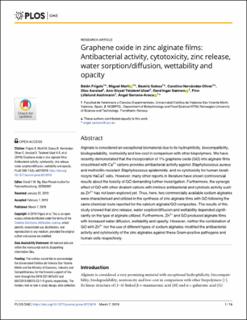| dc.contributor.author | Frigols, Belen | |
| dc.contributor.author | Marti, Miguel | |
| dc.contributor.author | Salesa, Beatriz | |
| dc.contributor.author | Hernandez-Oliver, Carolina | |
| dc.contributor.author | Aarstad, Olav Andreas | |
| dc.contributor.author | Ulset, Ann-Sissel Teialeret | |
| dc.contributor.author | Sætrom, Gerd Inger | |
| dc.contributor.author | Aachmann, Finn Lillelund | |
| dc.contributor.author | Serrano-Aroca, Angel | |
| dc.date.accessioned | 2020-03-23T10:53:29Z | |
| dc.date.available | 2020-03-23T10:53:29Z | |
| dc.date.created | 2020-02-21T10:57:43Z | |
| dc.date.issued | 2019 | |
| dc.identifier.citation | PLOS ONE. 2019, 14 (3), . | en_US |
| dc.identifier.issn | 1932-6203 | |
| dc.identifier.uri | https://hdl.handle.net/11250/2648060 | |
| dc.description.abstract | Alginate is considered an exceptional biomaterial due to its hydrophilicity, biocompatibility, biodegradability, nontoxicity and low-cost in comparison with other biopolymers. We have recently demonstrated that the incorporation of 1% graphene oxide (GO) into alginate films crosslinked with Ca2+ cations provides antibacterial activity against Staphylococcus aureus and methicillin-resistant Staphylococcus epidermidis, and no cytotoxicity for human keratinocyte HaCaT cells. However, many other reports in literature have shown controversial results about the toxicity of GO demanding further investigation. Furthermore, the synergic effect of GO with other divalent cations with intrinsic antibacterial and cytotoxic activity such as Zn2+ has not been explored yet. Thus, here, two commercially available sodium alginates were characterised and utilized in the synthesis of zinc alginate films with GO following the same chemical route reported for the calcium alginate/GO composites. The results of this study showed that zinc release, water sorption/diffusion and wettability depended significantly on the type of alginate utilized. Furthermore, Zn2+ and GO produced alginate films with increased water diffusion, wettability and opacity. However, neither the combination of GO with Zn2+ nor the use of different types of sodium alginates modified the antibacterial activity and cytotoxicity of the zinc alginates against these Gram-positive pathogens and human cells respectively. | en_US |
| dc.language.iso | eng | en_US |
| dc.publisher | Public Library of Science | en_US |
| dc.rights | Navngivelse 4.0 Internasjonal | * |
| dc.rights.uri | http://creativecommons.org/licenses/by/4.0/deed.no | * |
| dc.title | Graphene oxide in zinc alginate films: Antibacterial activity, cytotoxicity, zinc release, water sorption/diffusion, wettability and opacity | en_US |
| dc.type | Peer reviewed | en_US |
| dc.type | Journal article | en_US |
| dc.description.version | publishedVersion | en_US |
| dc.source.pagenumber | 18 | en_US |
| dc.source.volume | 14 | en_US |
| dc.source.journal | PLOS ONE | en_US |
| dc.source.issue | 3 | en_US |
| dc.identifier.doi | 10.1371/journal.pone.0212819 | |
| dc.identifier.cristin | 1796404 | |
| dc.relation.project | Norges forskningsråd: 226244 | en_US |
| dc.description.localcode | © 2019 Frígols et al. This is an open access article distributed under the terms of the Creative Commons Attribution License, which permits unrestricted use, distribution, and reproduction in any medium, provided the original author and source are credited. | en_US |
| cristin.ispublished | true | |
| cristin.fulltext | original | |
| cristin.qualitycode | 1 | |

